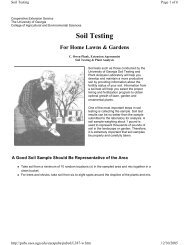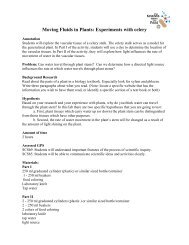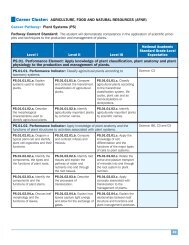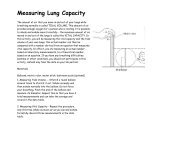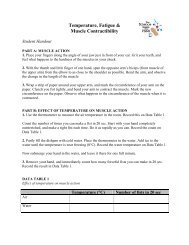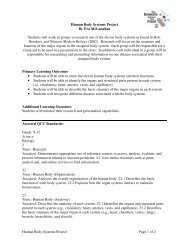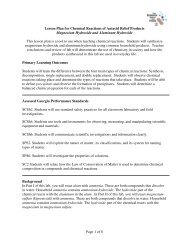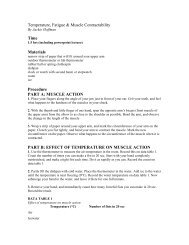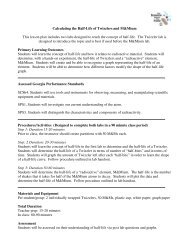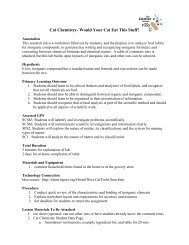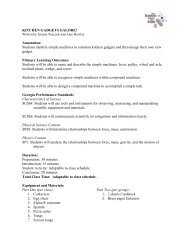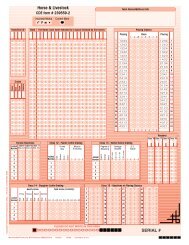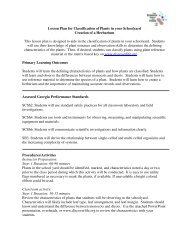Basic Agriculture Science - Georgia Department of Education
Basic Agriculture Science - Georgia Department of Education
Basic Agriculture Science - Georgia Department of Education
Create successful ePaper yourself
Turn your PDF publications into a flip-book with our unique Google optimized e-Paper software.
<strong>Georgia</strong> <strong>Department</strong> <strong>of</strong> <strong>Education</strong><br />
ELACC9-10SL2: Integrate multiple sources <strong>of</strong> information presented in diverse media or formats<br />
(e.g., visually, quantitatively, orally) evaluating the credibility and accuracy <strong>of</strong> each source.<br />
SEV4: Students will understand and describe availability, allocation and conservation <strong>of</strong> energy<br />
and other resources.<br />
a. Differentiate between renewable and nonrenewable resources including how different<br />
resources are produced, rates <strong>of</strong> use, renewal rates, and limitations <strong>of</strong> sources. Distinguish<br />
between natural and produced resources.<br />
b. Describe how technology is increasing the efficiency <strong>of</strong> utilization and accessibility <strong>of</strong><br />
resources.<br />
c. Describe how energy and other resource utilization impact the environment and recognize<br />
that individuals as well as larger entities (businesses, governments, etc.) have impact on<br />
energy efficiency.<br />
d. Describe the relationship <strong>of</strong> energy consumption and the living standards <strong>of</strong> societies.<br />
e. Describe the commonly used fuels (e.g. fossil fuels, nuclear fuels, etc.) and some alternative<br />
fuels (e.g. wind, solar, ethanol, etc.) including the required technology, availability, pollution<br />
problems and implementation problems. Recognize the origin <strong>of</strong> fossil fuels and the problems<br />
associated with our dependence on this energy source.<br />
f. Describe the need for informed decision making <strong>of</strong> resource utilization (i.e. energy and water<br />
usage allocation, conservation, food and land, and long-term depletion).<br />
Course Standard 13<br />
AFNR-BAS-13<br />
Explain and demonstrate basic plant science principles including plant health, growth and<br />
reproduction.<br />
13.1 Describe basic factors in plant growth.<br />
13.2 Identify plant life cycles and list examples.<br />
13.3 Label the major parts <strong>of</strong> the plant and explain functions <strong>of</strong> each plant part.<br />
13.4 Compare and contrast photosynthesis, respiration, and transpiration and state their<br />
importance.<br />
13.5 Identify important floriculture and nursery/landscape plants utilized in <strong>Georgia</strong>.<br />
13.6 Explain the roles <strong>of</strong> essential plant nutrients for plant growth and reproduction.<br />
13.7 Debate the use <strong>of</strong> organic and inorganic fertilizers in plant production.<br />
13.8 Illustrate and demonstrate sexual and asexual methods <strong>of</strong> various plant propagation<br />
techniques.<br />
13.9 Sequence the steps <strong>of</strong> pollination and fertilization.<br />
13.10 Demonstrate scarification, stratification, and planting seeds.<br />
13.11 Outline germination steps and list conditions under which germination occurs.<br />
13.12 Analyze skills, education requirements, income, and advantages and disadvantages <strong>of</strong><br />
careers in the plant science industry.<br />
<strong>Georgia</strong> <strong>Department</strong> <strong>of</strong> <strong>Education</strong><br />
Dr. John D. Barge, State School Superintendent<br />
January 25, 2013 ·Page 8 <strong>of</strong> 9<br />
All Rights Reserved



